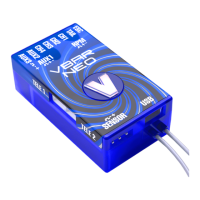3. Preparing the Transmitter
If you are using VBar Control, please refer to the VBar Control
Manual to bind and set up your model.
If you are using a different radio system, in your transmitter,
choose a new model and select a heli program with swash
plate conguration H-1 or with mechanical mixing (1 Servo).
When using VBar, swash plate mixing in the transmitter is not
necessary. However, you do need to use other functions which
are adjustable in heli programs only, such as ight modes,
autorotation and so on.
Set all transmitter trims to zero or switch off all trimming
functions. This is important because a change in trimming,
e.g. in ight modes in the transmitter, is interpreted by VBar
as control inputs, which will lead to drift.
The transmitter needs to be calibrated in setup mode. That is,
all center and end positions of all channels need to be aligned
with VBar. (See Adjusting the Transmitter.)
You may use the dual rate function for adjusting agility, and
the expo function for adjusting control behavior around stick
center. You can set this differently for different ight modes.
At least six radio channels are required, four for the control
functions as well as one each for the motor switch and bank
switching (= ight modes). For the optional rescue feature or
other additional functions (e.g. gear, light), additional channels
may be necessary.

